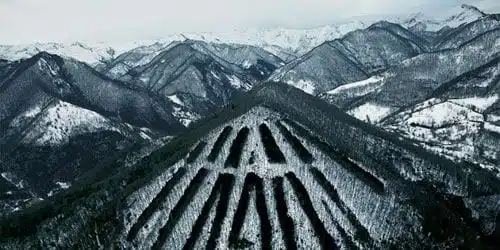
The latest in a series of aesthetically pleasing and educational (or scaremongering, depending on your world view) portrayals of the glories of our blue planet is Home, narrated by Glenn Close. Taking cues from the BBC/Discovery Channel’s Planet Earthseries as well as Al Gore’s An Inconvenient Truth, Home doesn’t quite manage to distinguish itself from its predecessors. Close’s script rarely tells the viewer what we’re looking at; no matter how gorgeous the images, they cannot stand completely alone.
There is no doubt that much of the aerial photography gathered by award-winning photographer Yann Arthus-Bertrand is jaw-dropping in its beauty. Arthus-Bertrand has spent years systematically photographing the planet from the air and making those images available as a part of various collections and UNESCO-funded projects; his website is a fabulous resource for incredible photographs (they’re free; you can go get some stunning desktop wallpaper).
The narration describes the origins of Earth to start with, but the images don’t completely match with what Close is saying, and the lack of perspective in many shots doesn’t help the viewer know whether we’re looking at something under a microscope, or something from a mile-high aerial view. The language is appropriate for an elementary school lesson about science and the origins of life, which doesn’t fit with the complexity and elegance of the visuals.
The two hour DVD is billed as “A stunning visual portrayal of earth”, and it is, but a confusing one. At times the narrator’s voice falls silent, allowing for a few moments of full viewer absorption in the spectacular landscapes the the camera pans over. Then suddenly the voice is back, discussing some point of agricultural catastrophe that may or may not fit with the current images. And the audio fades in and out, growing suddenly softer, as though something went wrong with the fader during the final sound edits.
Throughout, the writers have decided to couch all references to oil in phrases such as “pockets of sunlight” – adding something like a touch of whimsy even while the looming difficulties of life without easy access to oil are meant to be threatening and serious. Close reads, “The most urgent priority is to pick every pocket of sunlight.” The depletion of petroleum reserves is emphasized alongside other diminished resources, but no other fight for naturally-occurring materials gets the same nickname-y treatment.
One of the best juxtapositions in the production starts with an image of Dakar, Senegal, the westernmost city in Africa and traditional net-fishing efforts there. Following a scene of the local fishing industry borne on shallow coastal waters, the camera cuts to a shot of a desert where people struggle to draw water from a deep well, originating in an aquafir thousands of years old. Home resonates most powerfully when the camera observes people in their home environments, interacting with the natural world.
With a wealth of stunning photography to draw from, Arthus-Bertrand has used some incredible images to illustrate relationships between climates and geographical features. Everywhere, people struggle to survive, and it’s amazing that this can be the case whether they live near open water or thousands of miles away, whether they live near a major urban center or closer to a village setting largely inhabited by livestock rather than people. Each setting presents its own challenges and wonders.
Home offers no interviews or commentary, but allows the presentation of aerial video to stand alone visually. Besides Close’s accompaniment, there is a varied soundtrack of soaring classical and operatic vocals providing an audio backdrop to the narration. Armand Amar put together the original score, and at times it fits well and at other times is simply too dramatic to stand up to the narration even when paired with the incredible photography.
The packaging notes that the production spans 54 countries and 120 locations, but most are not identified throughout the piece itself, so it’s hard to get a sense of how much territory was really covered. Finally, during the credit sequence at the end of the production, a number of scenes from the film are replayed and identified with a small caption bearing the country name.
The packaging also makes a small mention of the producers’ profits from the film going back to GoodPlanet.org, and using environmentally friendly technology to produce the casing. The organization provides a forum for discussion about the environment, as well as hosting the full length film so it can be viewed as widely as possible. Though the production may have its flaws, Arthus-Bertrand and his colleagues certainly have the interests of the planet at heart.

